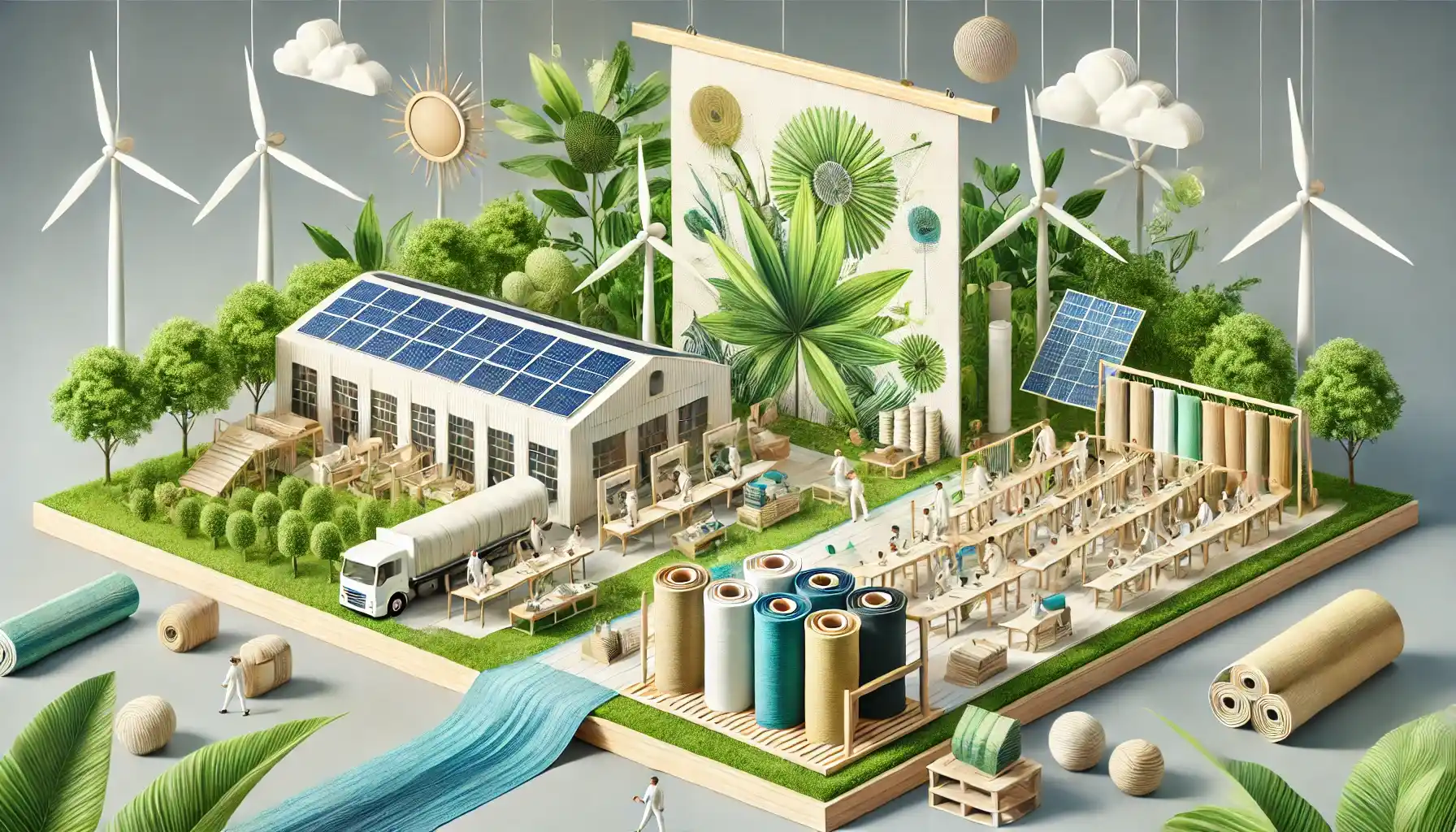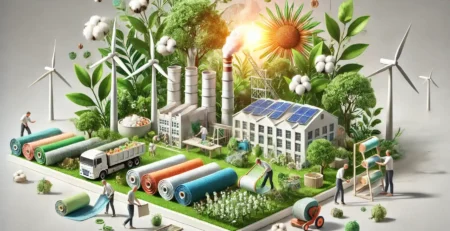
12
Mar
Eco-Friendly Production: Reducing Carbon Footprint in Textile Manufacturing
The textile industry is one of the largest contributors to global carbon emissions, water pollution, and environmental degradation. Traditional textile manufacturing relies heavily on fossil fuels, synthetic chemicals, and excessive water consumption, making it a key sector in need of sustainable transformation.
To address these challenges, many manufacturers are shifting toward eco-friendly production methods to reduce their carbon footprint while meeting consumer demand for sustainable products. From utilizing renewable energy to adopting biodegradable materials like jute, brands are embracing greener alternatives.
Understanding Carbon Footprint in Textile Manufacturing
What is Carbon Footprint?
A carbon footprint refers to the total amount of greenhouse gases (GHGs), particularly carbon dioxide (CO₂), emitted during the production and lifecycle of a product. In textile manufacturing, carbon emissions arise from:
- Energy-intensive production processes (spinning, weaving, dyeing, finishing)
- Transportation of raw materials and finished goods
- Use of synthetic fibers derived from petroleum
- Water and chemical waste from dyeing and processing
Why is Reducing Carbon Footprint Important?
Minimizing carbon emissions in textile production benefits both the environment and businesses by:
✔ Lowering environmental impact by reducing air and water pollution
✔ Improving brand reputation among eco-conscious consumers
✔ Complying with global sustainability regulations
✔ Reducing operational costs through energy efficiency and waste reduction
To achieve eco-friendly production, manufacturers are implementing sustainable strategies, including adopting biodegradable materials like jute and transitioning to low-impact production techniques.
Sustainable Practices in Textile Manufacturing
1. Switching to Renewable Energy
One of the most effective ways to cut carbon emissions is by shifting from fossil fuels to renewable energy sources, such as:
- Solar Power: Reduces dependence on coal-based electricity.
- Wind Energy: Provides a clean and sustainable power source.
- Hydroelectric Power: Uses water currents to generate electricity with minimal emissions.
Leading textile companies are investing in solar-powered factories and wind farms to operate sustainably and reduce their reliance on non-renewable energy.
2. Using Eco-Friendly Raw Materials
The choice of raw materials significantly impacts a product’s carbon footprint. Sustainable textiles include:
- Organic Cotton: Grown without synthetic pesticides and fertilizers.
- Jute: A biodegradable fiber used in eco-friendly promotional jute bags and sustainable packaging.
- Hemp: Requires minimal water and no synthetic fertilizers.
- Recycled Fabrics: Made from post-consumer waste, reducing landfill pollution.
By using biodegradable and low-impact textiles, eco-friendly promotional bag manufacturers are offering sustainable alternatives to plastic-based products.
3. Implementing Water-Saving Techniques
Textile dyeing and finishing processes are among the most water-intensive operations. Sustainable manufacturers are adopting:
- Low-Water Dyeing Technologies (e.g., digital printing, CO₂ dyeing)
- Closed-Loop Water Recycling Systems to reuse water multiple times
- Plant-Based Dyes to eliminate toxic chemicals
These strategies help in reducing wastewater pollution and conserving natural water resources.
4. Minimizing Waste Through Circular Fashion
The circular economy in textiles focuses on:
- Recycling post-consumer textiles to create new fabrics.
- Upcycling old materials into new designs.
- Using compostable materials like jute for promotional and packaging solutions.
Eco-friendly promotional product manufacturers are designing reusable, recyclable, and biodegradable promotional items to align with circular economy principles.
5. Reducing Transportation Emissions
The global supply chain in the textile industry contributes significantly to carbon emissions due to long-distance shipping. Sustainable brands are:
- Sourcing locally to minimize transportation distances.
- Using energy-efficient logistics to reduce fuel consumption.
- Partnering with carbon-neutral shipping companies.
Many eco-friendly promotional bag manufacturers now prioritize local production to reduce their carbon footprint while supporting regional economies.
6. Adopting Sustainable Packaging
Sustainable packaging is essential in reducing overall waste. Many brands are replacing plastic with:
- Jute and Cotton Bags: Durable, biodegradable, and stylish.
- Recycled Paper Packaging: Minimizes plastic pollution.
- Compostable Mailers: Made from plant-based materials.
Businesses investing in eco-friendly jute promotional bags are offering customers reusable alternatives that promote sustainability while enhancing brand visibility.
The Role of Eco-Friendly Promotional Products in Sustainability
Why Businesses Are Investing in Eco-Friendly Promotional Bags
Promotional products are widely used for marketing, but traditional giveaways (plastic pens, synthetic tote bags, and non-recyclable packaging) contribute to environmental waste.
Brands are now choosing eco-friendly promotional products, particularly jute and cotton bags, because they are:
✔ Reusable and biodegradable
✔ Trendy and customizable for brand promotion
✔ Ethically sourced from sustainable supply chains
✔ Cost-effective and long-lasting
How Eco-Friendly Jute Promotional Bags Reduce Carbon Footprint
Jute bags are becoming the preferred choice for sustainable marketing due to their:
- Biodegradability – Decomposes naturally without harming the environment.
- Low carbon footprint – Jute absorbs CO₂ and releases oxygen at a high rate.
- Durability – Reusable for years, replacing disposable plastic bags.
- Stylish Appeal – Ideal for corporate branding, retail packaging, and promotional events.
Many eco-friendly promotional bag manufacturers now offer customized jute promotional bags to businesses looking to align their brand with sustainability.
Future Trends in Sustainable Textile Manufacturing
As sustainability becomes a priority, emerging trends in eco-friendly textile production include:
- Biofabrication: Using lab-grown fibers made from microbes.
- Smart Textiles: Fabrics that adapt to environmental conditions, reducing waste.
- Blockchain Transparency: Tracking carbon emissions in the textile supply chain.
- AI-Powered Manufacturing: Optimizing energy efficiency through automation.
With these innovations, eco-friendly promotional product manufacturers and textile brands will continue to reduce their environmental impact while meeting the growing demand for sustainable products.
FAQs on Eco-Friendly Production in Textile Manufacturing
1.What is eco-friendly production in textiles?
Eco-friendly production refers to sustainable textile manufacturing methods that reduce carbon emissions, minimize waste, and conserve natural resources.
2.How can textile manufacturers reduce their carbon footprint?
They can switch to renewable energy, use sustainable fabrics like jute and hemp, implement water-saving techniques, and minimize transportation emissions.
3.Why are businesses choosing eco-friendly promotional bags?
Eco-friendly bags, especially jute and cotton, are biodegradable, reusable, and stylish, making them a sustainable alternative to plastic promotional products.
4.What are the benefits of using jute promotional bags?
Jute bags are durable, compostable, cost-effective, and offer an attractive way to promote brands sustainably.
5.How does circular fashion help reduce textile waste?
Circular fashion promotes recycling, upcycling, and composting of fabrics, preventing waste from ending up in landfills.
6.What makes jute an environmentally friendly material?
Jute requires minimal water, no synthetic fertilizers, and absorbs CO₂, making it a low-impact fiber.
7.Are eco-friendly promotional product manufacturers expensive?
While initially slightly costlier than synthetic products, sustainable options offer long-term cost savings and environmental benefits.
8.How do digital dyeing technologies help reduce carbon emissions?
Digital printing and CO₂ dyeing use less water and chemicals, minimizing pollution and energy consumption.
9.What role does renewable energy play in sustainable textile production?
Solar and wind energy reduce dependence on fossil fuels, lowering carbon emissions from textile factories.
10.What are the future trends in eco-friendly textile manufacturing?
Biofabrication, AI-powered efficiency, blockchain transparency, and smart textiles will drive the next wave of sustainable innovations.
Eco-friendly production is reshaping the textile industry by reducing carbon emissions, conserving resources, and promoting sustainability. From eco-friendly promotional product manufacturers to eco-friendly jute promotional bags, businesses are adopting greener alternatives to align with environmental goals.
By implementing renewable energy, sustainable fabrics, water-saving technologies, and ethical production, textile manufacturers are paving the way for a greener and more responsible future.





